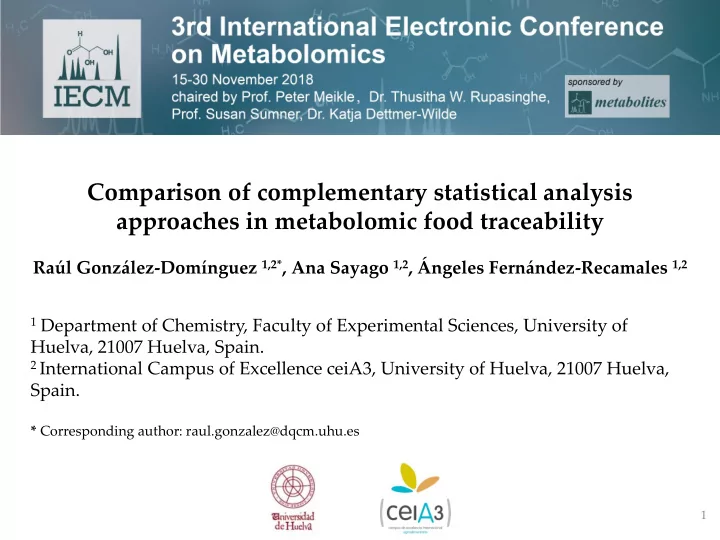

Comparison of complementary statistical analysis approaches in metabolomic food traceability Raúl González-Domínguez 1,2* , Ana Sayago 1,2 , Ángeles Fernández-Recamales 1,2 1 Department of Chemistry, Faculty of Experimental Sciences, University of Huelva, 21007 Huelva, Spain. 2 International Campus of Excellence ceiA3, University of Huelva, 21007 Huelva, Spain. * Corresponding author: raul.gonzalez@dqcm.uhu.es 1
Comparison of complementary statistical analysis approaches in metabolomic food traceability 2
Abstract: Metabolomics generates large datasets that require the use of advanced and complementary statistical tools in order to extract the maximum amount of useful information. In this work, we show the advantages, limitations and complementarities of these techniques in food analysis, on the basis of data acquired in various traceability studies performed in our research group with strawberry and extra virgin olive oil. Keywords: food traceability; machine learning; pattern recognition 3
Introduction Omic technologies large datasets Pattern recognition techniques: Principal component analysis (PCA), partial least squares discriminant analysis (PLS-DA), soft independent model class analogy (SIMCA) Machine learnig techniques: random forest (RF), support vector machines (SVM), artificial neural network (ANN) 4
Introduction Partial least square discriminant analysis Principal component analysis overview of data and identification of discrimination between previously defined outliers and trends categories 10 10 5 5 0 t[2] 0 t[2] -5 -5 -10 -10 -15 -12 -10 -8 -6 -4 -2 0 2 4 6 8 10 12 -4 -3 -2 -1 0 1 2 3 4 t[1] t[1] most commonly employed tools in metabolomics 5
Introduction Soft independent model class analogy Look for possible overlapping among the study groups 6 M2.DModXPS+[2](Norm) 5 4 3 2 D-Crit(0,05) D-Crit(0,05) 1 0 0 1 2 3 4 5 M1.DModXPS+[2](Norm) 6
Introduction Machine learning techniques Artificial neural network Random forest Support vector machines Model performance sensitivity (SENS): percentage of cases belonging to a determinate class correctly classified specificity (SPEC): percentage of cases not belonging to a class and rejected by this class model 7
Materials and Methods Three varieties GC-MS un-targeted 2 macrotunnel types metabolomics 1 3 conductivities of irrigation LC-MS targeted 3 soilless substrates metabolomics 2 ICP-MS multielemental profiling 3 1 H-NMR + GC/LC profiling unsaponifiable fraction 4 (1) Akhatou et al. Plant Physiol. Biochem. 101 (2016) 14-22 (2) Akhatou et al. J. Agric. Food Chem. 65 (2017) 9559-9567 (3) Sayago et al. Food Chem. 261 (2018) 42 – 50 (4) Sayago et al. Under preparation 8
Results and Discussion Differentiation of strawberry cultivars based on GC-MS metabolomic profiles PLS-DA PCA PCA showed good clustering of study groups PLS-DA to search for discriminant metabolites between varieties: sugars, organic acids, amino acids conventional statistical pipeline in metabolomics Akhatou et al. Plant Physiol. Biochem. 101 (2016) 14-22 9
Results and Discussion Differentiation of strawberry cultivars based on LC-MS metabolomic profiles PLS-DA Similar metabolic changes were observed in RF both models: anthocyanins, ellagic acid derivatives RF modeling provided higher sensitivity and similar specificity Akhatou et al. J. Agric. Food Chem. 65 (2017) 9559-9567 10
Results and Discussion Differentiation of olive oil provenance based on ICP-MS mineral profiles Three predictive modelling aproaches were compared to classify EVOOs according to three geographical origins Machine learning tools (RF and SVM) provided higher sensitivity than PLS-DA models Specificity was slightly higher in PLS-DA models Sayago et al. Food Chem. 261 (2018) 42 – 50 11
Results and Discussion Differentiation of olive oil variety based on 1 H-NMR and the unsaponifiable fraction PLS-DA Arbequina Picual Verdial Model SENS SPEC SENS SPEC SENS SPEC SVM 100 100 100 96 87.5 100 RF 100 93.3 100 85.3 12.5 100 ANN 100 100 100 100 100 100 SIMCA SIMCA complements to PLS-DA with the aim of looking for possible overlapping among study groups Machine learning tools provide similar statistical performance Sayago et al. Under preparation 12
Conclusions Multiple multivariate statistical tools can be complementarily employed to manage complex omic datasets Unsupervised PCA can be used to get an overview of data and to identify trends towards the grouping of samples PLS-DA is the most commonly used pattern recognition method to build classification models Advanced machine learning algorithms (RF, SVM, ANN) are complementary to conventional statistical techniques, which usually provide better statistical performance in terms of sensitivity and specificity 13
Recommend
More recommend